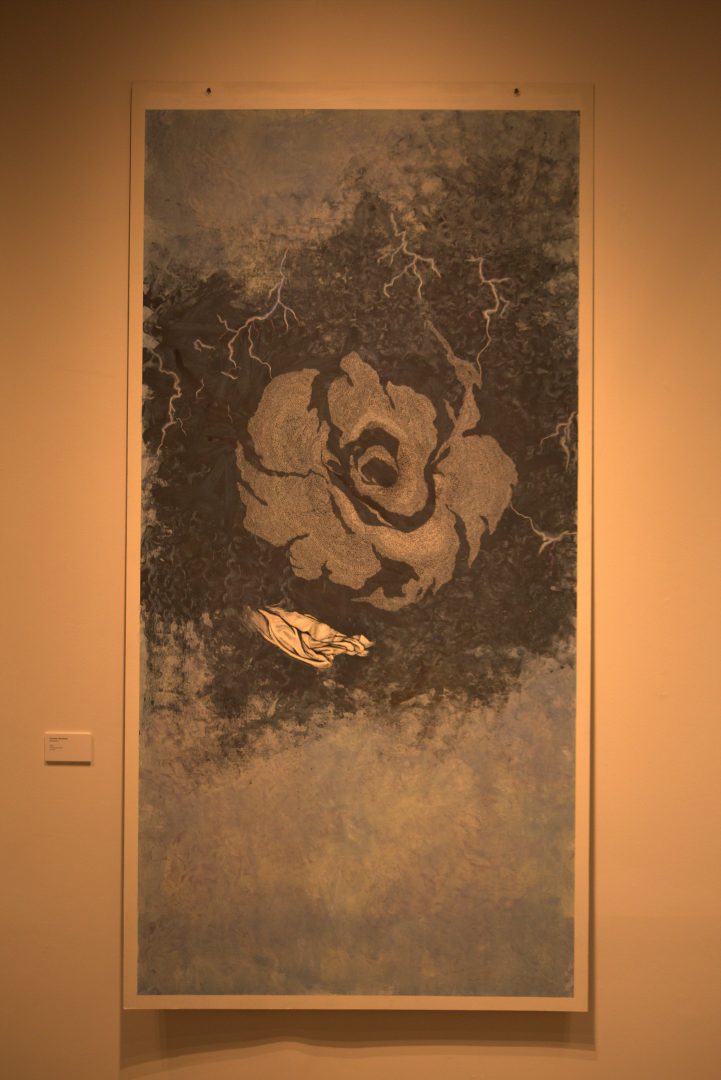The second graduate art show of the fall semester kicked off with a reception on Oct. 27 at the Phebe Conley Art Gallery, showcasing three Fresno State graduate students’ artworks.
Jose Lopez, who is pursuing a master’s degree in sculpture, has many pieces on display as social commentary on issues that he and other people are facing in the country, like gun violence, COVID-19 and climate change.
One of Lopez’s pieces, called “Interval Caching,” illustrates a floating earth covered with trash with four skull sculptures beneath it.
“These four skulls represent presidential election cycles, where they get concerned with pollution, they get concerned with all the top main topics, and then you kind of forget about it, or they don’t pass laws,” Lopez said.
The trash on the earth represents the planet covered with pollution by people who don’t care about the environment, according to Lopez.
Lopez experimented with wax when making the skulls, connecting them with bronze pieces in what is called the lost-wax method. He also uses magnetic technology, like using wires to make the earth float and hiding the wires within the skulls.
“I figured to personalize it myself and make something related to some kind of social aspect, which in this case, would be pollution and the political cycle,” Lopez said.
One of Lopez’s other pieces on display, titled “E Minor,” uses microchips to replicate a city, representing how people use technology in everyday life.
Lopez collected these chips from a warehouse that he lived nearby that often discarded electronic toys. He also noted that the work represents electronic waste.
Lopez also said the artwork comments on the state of developed nations exploiting third-world countries for chips.
“If you look at where all these electronics [go]… they go to Africa. They go out to all these developing countries where they burn them to try to get the gold out, try to get these raw materials out of them,” Lopez said.
The second hall features paintings by Priscilla Yamamoto, who is pursuing a master’s degree in drawing and painting.
Her art focuses on the abstract of the human mind, illustrated by one of her pieces titled “Butterfly.”
“Butterfly” is split between the gallery halls, representing parallel worlds.
“It could be life and death, could be two different feelings, physical and spiritual, all kinds of dual ideas,” Yamamoto said.
Another of her works is a set of three paintings called “The Vortex,” illustrating two people who look as if they are tired and touching the wall. In the middle canvas is a vortex.
According to Yamamoto, the person standing has a wave of music because he is a composer and that “they want to revisit this place where they both share.”
Yamamoto’s “Ghost of Fly” is also on display, depicting a person falling into a bathtub to represent escaping to another world. When drawing, Yamamoto said she took inspiration from one of her favorite novels by Haruki Murakami in which a man is sleeping in a well and is dreaming.
“When he emerges from the well, it’s like he kind of solved a lot of his subconscious or psychological issues, and you come out kind of brand new,” Yamamoto said.
According to Yamamoto, a majority of her art is left to the interpretation of the viewer because she believes that the audience has different meanings and feelings when it comes to seeing her work.
The work of Erin Ryan, who is pursuing a master’s degree in art, is also on display. Many of Ryan’s pieces are centered on their personal experiences transitioning from their gender assigned at birth into their nonbinary identity, serving as a “documentation” of their experiences, according to their artist’s statement.
In particular, Ryan’s artwork works to examine the “liberating potential of acceptance while also challenging Julia Kristeva’s theory of the abject: ‘that which disturbs system, identity, order’, and encompasses a borderline uncertainty — ambiguous, horrifying and polluting.”
A series of three self-portraits are on display, with the first in the series created in 2020 depicting the self-portrait from Ryan’s own perspective looking at their reflection through a mirror.
Through the artwork, Ryan said they hope to illustrate that LGBTQ+ people love themselves for who they are.
Another of Ryan’s artworks on display, titled “Daydream of a Peaceful Future,” depicts a sunrise transgender flag as the sky with clouds.
“I see a peaceful future as a trans future. It’s not about singular individuals in society, it’s about the collective trans community and our future together,” Ryan said.
Lastly, one of Ryan’s standout pieces is “Trans Joy.” The artwork details a joyful figure, and is composed of hair on a tiled closet door.
“By using cast off materials like hair to portray the beauty of trans and queer bodies as fine art, I reject both Kristeva’s theory of abjection and the system it upholds,” Ryan said. “The medium of hair is polarizing. Some people really like my work, and others are repulsed.”
The graduate art show will be open for viewing through Nov. 18 on Mondays through Fridays from 10 a.m. to 4 p.m.




